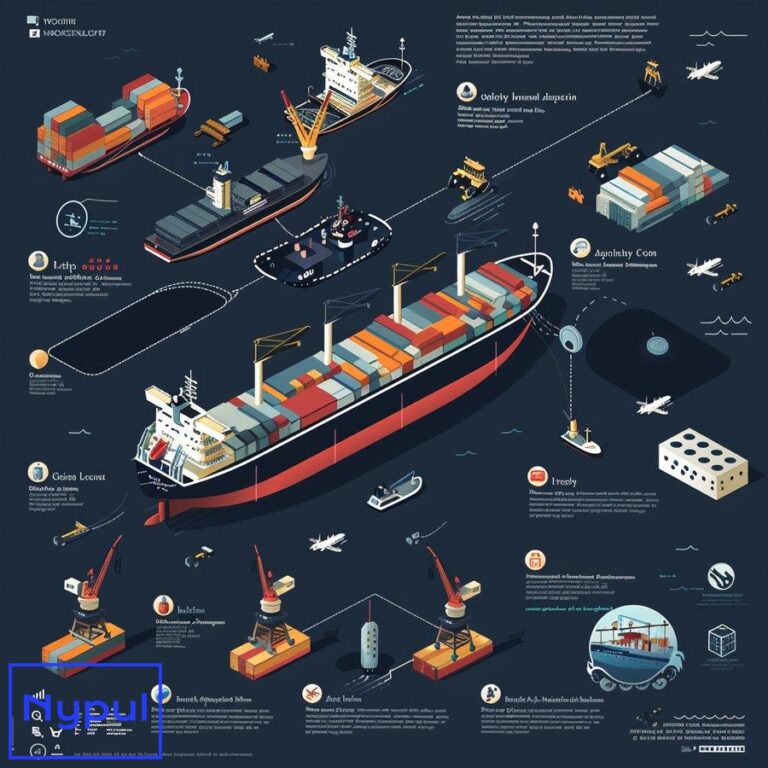What Is Port to Door Service
Port to door service is a comprehensive logistics solution that bridges the gap between international shipping and final delivery. This service encompasses the transportation of goods from a port of origin to the recipient’s doorstep, streamlining the complex process of global trade.
At its core, port to door service involves:
Port handling: The service begins at the port where the shipment arrives. This includes unloading from the vessel, customs clearance, and preparation for inland transportation.
Inland transportation: Once cleared, the goods are transported via truck, rail, or a combination of modes to reach the final destination.
Last-mile delivery: The final step involves delivering the shipment directly to the recipient’s address, whether it’s a residence, business, or warehouse.
Port to door service offers a seamless transition from international to domestic logistics, eliminating the need for importers to manage multiple transportation legs. This service is particularly valuable for businesses that lack the resources or expertise to handle complex shipping arrangements.
Key benefits of port to door service include:
Simplified logistics: Shippers deal with a single point of contact for the entire journey, reducing coordination efforts and potential miscommunications.
Cost-effectiveness: By consolidating services, businesses can often achieve better rates and avoid hidden fees associated with multiple service providers.
Enhanced tracking: Many port to door services offer end-to-end visibility, allowing shippers and recipients to monitor their cargo throughout the entire journey.
Reduced risk: Professional handling at every stage minimizes the chances of damage, loss, or delays.
Customs expertise: Service providers typically handle customs clearance, navigating complex regulations and documentation requirements.
For businesses engaged in international trade, understanding port to door service is crucial. It represents a strategic approach to managing the complexities of global supply chains, offering a balance between efficiency, cost-effectiveness, and reliability.
How does port to door service differ from other shipping methods?
Port to door service is one of several shipping methods available in international logistics. To fully appreciate its unique features, it’s essential to compare it with other common shipping options:
Port to Port vs. Port to Door

Port to port shipping involves transporting goods from one port to another, without inland transportation or final delivery services.
| Aspect | Port to Port | Port to Door |
|---|---|---|
| Scope | Limited to sea/air transport | Includes inland transport and delivery |
| Responsibility | Ends at destination port | Extends to final destination |
| Customs clearance | Not typically included | Often included |
| Suitable for | Importers with own logistics capabilities | Businesses seeking end-to-end solutions |
Door to Door vs. Port to Door
Door to door service covers the entire journey from the shipper’s location to the recipient’s address, including pickup at origin.
| Aspect | Door to Door | Port to Door |
|---|---|---|
| Origin handling | Included | Not included |
| Scope | Complete end-to-end service | Partial end-to-end service |
| Cost | Generally higher | More economical |
| Control | Less control for shipper | More control at origin |
Port to Door vs. Port to Airport
Port to airport service terminates at the destination airport, while port to door extends to the final delivery address.
| Aspect | Port to Door | Port to Airport |
|---|---|---|
| Final leg | Includes ground transport to destination | Ends at airport |
| Suitable for | General cargo | Often used for air freight |
| Delivery flexibility | Higher | Lower |
| Handling requirements | Varied based on cargo type | Specific to air cargo regulations |
Key Differentiators of Port to Door Service
Flexibility: Port to door offers more flexibility than port to port or port to airport services, accommodating various cargo types and destinations.
Cost structure: While potentially more expensive than port to port, it often proves more cost-effective than full door to door service for businesses with efficient export processes.
Risk management: By extending responsibility to the final destination, port to door service providers assume more risk, potentially reducing liability for shippers.
Documentation: Port to door typically involves more comprehensive documentation handling, including customs clearance and last-mile delivery paperwork.
Tracking capabilities: Often provides more extensive tracking than port to port, offering visibility from port arrival to final delivery.
Understanding these differences allows businesses to choose the most appropriate shipping method based on their specific needs, capabilities, and risk tolerance. Port to door service strikes a balance between comprehensive coverage and cost-effectiveness, making it an attractive option for many international shippers.
What are the key steps in the port to door process?
The port to door process involves several critical steps, each playing a vital role in ensuring the smooth transition of goods from international shipping to final delivery. Understanding these steps helps shippers and recipients anticipate the journey of their cargo and plan accordingly.
1. Arrival at Port of Destination
Vessel docking: The ship carrying the cargo arrives at the destination port.
Unloading: Containers or loose cargo are unloaded from the vessel using specialized equipment.
Initial inspection: Port authorities conduct preliminary checks for damage or discrepancies.
2. Customs Clearance
Documentation submission: Required paperwork is submitted to customs authorities.
Customs inspection: Officials may physically inspect the cargo or conduct document reviews.
Duty and tax payment: Applicable import duties and taxes are calculated and paid.
Release approval: Once cleared, customs issues a release for the shipment.
3. Port Handling and Storage
Temporary storage: If immediate pickup isn’t possible, cargo is stored in port facilities.
Sorting and consolidation: For less-than-container load (LCL) shipments, cargo may be consolidated with other shipments.
Equipment preparation: Containers or trucks are prepared for inland transportation.
4. Inland Transportation Arrangement
Mode selection: The appropriate mode of transport (truck, rail, or intermodal) is chosen.
Route planning: The most efficient route to the final destination is determined.
Scheduling: Pickup and delivery times are coordinated with relevant parties.
5. Cargo Loading and Departure
Equipment inspection: Trucks or containers are inspected for safety and compliance.
Cargo loading: Goods are carefully loaded onto the chosen transport vehicle.
Documentation check: Transport documents are verified before departure.
6. Transit to Final Destination
Transportation: Cargo is moved via the chosen mode of transport.
Tracking and monitoring: The shipment’s progress is tracked throughout the journey.
Handling of any issues: Any unexpected events or delays are addressed promptly.
7. Last-Mile Delivery
Delivery scheduling: A specific delivery time is coordinated with the recipient.
Final transport: The cargo is moved to the delivery vehicle for the last leg of the journey.
Recipient notification: The recipient is informed of the impending delivery.
8. Delivery and Documentation
Unloading at destination: Cargo is carefully unloaded at the recipient’s address.
Inspection: The recipient inspects the goods for any damage or discrepancies.
Proof of delivery: A delivery receipt is signed, confirming successful completion of the service.
Document handover: All relevant shipping documents are transferred to the recipient.
Each of these steps requires careful coordination and expertise. Port to door service providers manage this complex process, ensuring that shipments move smoothly from international waters to the recipient’s doorstep. By understanding these steps, shippers and recipients can better appreciate the value and complexity of port to door services, enabling them to make informed decisions about their shipping needs and to effectively communicate with service providers throughout the process.
Why choose port to door service for your shipping needs?
Selecting the right shipping method is crucial for businesses engaged in international trade. Port to door service offers several compelling advantages that make it an attractive option for many shippers. Understanding these benefits helps in making informed decisions about logistics strategies.
Streamlined Logistics Management
![]()
Port to door service simplifies the complex process of international shipping by providing a single point of contact for multiple logistics stages. This streamlined approach offers several benefits:
Reduced administrative burden: Dealing with one service provider instead of multiple entities for different legs of the journey simplifies paperwork and communication.
Improved coordination: A single provider managing the entire process from port to door ensures better synchronization between different transportation stages.
Time savings: Less time spent on logistics management allows businesses to focus on core activities.
Cost-Effectiveness
While the upfront cost of port to door service may seem higher than some alternatives, it often proves more economical in the long run:
Consolidated pricing: Bundling services can lead to overall cost savings compared to arranging each leg separately.
Reduced hidden costs: Fewer unexpected fees or charges typically arise when using a comprehensive service.
Economy of scale: Service providers often leverage their volume to negotiate better rates for inland transportation and handling.
Enhanced Visibility and Control
Port to door services typically offer advanced tracking and monitoring capabilities:
Real-time updates: Shippers and recipients can track their cargo’s progress throughout the entire journey.
Proactive issue management: Early detection of potential problems allows for timely interventions.
Data-driven insights: Comprehensive tracking data can inform future logistics decisions and improvements.
Risk Mitigation
Choosing port to door service can significantly reduce various risks associated with international shipping:
Reduced handling points: Fewer transfers between different parties minimize the risk of damage or loss.
Expert management: Professional handling at each stage reduces the likelihood of errors or oversights.
Insurance coverage: Many port to door services offer comprehensive insurance options for added protection.
Customs Expertise
Navigating customs regulations can be challenging, especially for businesses new to international trade:
Professional handling: Service providers are well-versed in customs procedures and documentation requirements.
Compliance assurance: Experts ensure all necessary regulations are followed, reducing the risk of delays or penalties.
Efficient clearance: Established relationships with customs authorities often lead to smoother, faster clearance processes.
Flexibility and Scalability
Port to door services can adapt to varying business needs:
Diverse cargo types: These services can handle a wide range of goods, from standard containers to specialized cargo.
Volume flexibility: Whether shipping small parcels or full container loads, port to door services can accommodate different volumes.
Geographic reach: Many providers offer extensive networks, allowing businesses to easily expand into new markets.
Enhanced Customer Satisfaction
For businesses selling to end customers, port to door service can significantly improve the buyer experience:
Reliable delivery timelines: More accurate delivery estimates lead to better customer expectations management.
Professional handling: Careful treatment of goods throughout the journey results in fewer damaged or lost items.
Convenient delivery: Direct delivery to the customer’s address enhances the overall shopping experience.
Choosing port to door service for your shipping needs offers a balance of convenience, cost-effectiveness, and professional management. It’s particularly beneficial for businesses looking to streamline their logistics processes, reduce risks, and improve overall efficiency in their international shipping operations. By leveraging the expertise and resources of specialized service providers, companies can focus on their core competencies while ensuring their goods reach their destinations safely and efficiently.
What challenges might you face with port to door shipping?

While port to door shipping offers numerous benefits, it’s important to be aware of potential challenges that may arise. Understanding these issues helps shippers prepare for and mitigate risks, ensuring smoother operations.
Customs Delays and Complexities
Customs clearance is often the most unpredictable part of the port to door process:
Documentation issues: Incomplete or incorrect paperwork can lead to significant delays.
Changing regulations: Frequent updates to customs rules can catch shippers off guard.
Inspections: Random or targeted inspections can extend clearance times unpredictably.
Mitigation strategies:
– Work closely with your service provider to ensure all documentation is complete and accurate.
– Stay informed about customs regulations in your target markets.
– Consider using a customs broker for complex shipments.
Last-Mile Delivery Challenges
The final leg of the journey can present unique difficulties:
Address accuracy: Incorrect or incomplete delivery addresses can cause delays or failed deliveries.
Access issues: Some locations may have restricted access or specific delivery requirements.
Recipient availability: Coordinating delivery times with recipients can be challenging, especially for residential deliveries.
Mitigation strategies:
– Double-check all address details before shipping.
– Provide clear delivery instructions, including access codes or preferred delivery times.
– Consider offering flexible delivery options, such as hold-for-pickup services.
Cost Fluctuations
Various factors can impact the cost of port to door services:
Fuel price volatility: Fluctuating fuel prices can affect transportation costs.
Peak season surcharges: Rates may increase during busy shipping periods.
Currency exchange rates: For international transactions, currency fluctuations can affect overall costs.
Mitigation strategies:
– Build some flexibility into your budget to account for potential cost increases.
– Consider long-term contracts with service providers to lock in rates.
– Explore hedging options for currency risks if dealing with significant international volumes.
Capacity Constraints
Limited availability of transportation resources can affect service reliability:
Port congestion: Overcrowded ports can lead to delays in unloading and processing.
Truck driver shortages: A lack of available drivers can impact inland transportation.
Equipment shortages: Scarcity of containers or specialized handling equipment can cause delays.
Mitigation strategies:
– Plan shipments well in advance, especially during peak seasons.
– Consider alternative ports or routes when facing severe congestion.
– Maintain open communication with your service provider about capacity issues.
Tracking and Visibility Gaps
While many providers offer advanced tracking, gaps can still occur:
Technology limitations: Some regions may have limited tracking capabilities.
Information delays: Real-time updates may not always be available, especially for multimodal shipments.
Data inconsistencies: Discrepancies between different tracking systems can cause confusion.
Mitigation strategies:
– Choose providers with robust tracking systems and integration capabilities.
– Establish clear communication protocols for updates and issue reporting.
– Implement your own tracking system to complement the provider’s offerings.
Regulatory Compliance
Navigating the complex landscape of international trade regulations can be challenging:
Varying requirements: Different countries have unique import/export regulations.
Frequent changes: Trade policies and regulations can change rapidly, affecting shipping processes.
Penalties for non-compliance: Failing to meet regulatory requirements can result in fines or shipment delays.
Mitigation strategies:
– Partner with service providers who have strong compliance expertise.
– Regularly review and update your compliance procedures.
– Consider joining trade associations to stay informed about regulatory changes.
Environmental Concerns
Increasing focus on sustainability presents new challenges for shipping:
Emissions regulations: Stricter environmental laws may impact shipping routes and methods.
Sustainable packaging requirements: Some regions are implementing stringent packaging regulations.
Carbon footprint considerations: Customers may demand more environmentally friendly shipping options.
Mitigation strategies:
– Explore eco-friendly shipping options offered by your service provider.
– Invest in sustainable packaging solutions.
– Consider carbon offset programs to mitigate environmental impact.
While these challenges can seem daunting, they are not insurmountable. By working closely with experienced port to door service providers, staying informed about industry trends, and maintaining flexibility in your logistics strategies, you can effectively navigate these obstacles. Remember, proactive planning and open communication are key to overcoming the challenges associated with port to door shipping.
How do you select a reliable port to door service provider?
Choosing the right port to door service provider is crucial for ensuring smooth, efficient, and cost-effective shipping operations. The selection process requires careful consideration of various factors to find a partner that aligns with your business needs and values. Here’s a comprehensive guide to help you make an informed decision:
Experience and Expertise
Look for providers with a proven track record in port to door services:
Years in business: Longevity often indicates stability and reliability.
Industry-specific experience: Providers familiar with your industry can offer valuable insights and tailored solutions.
Case studies and testimonials: Review their success stories and client feedback.
Network and Coverage
Assess the provider’s geographical reach and partnerships:
Global presence: Ensure they cover your key markets and potential expansion areas.
Port relationships: Strong connections with major ports can facilitate smoother operations.
Local expertise: Look for providers with knowledge of local customs and regulations in your target markets.
Service Portfolio
Evaluate the range of services offered:
Comprehensive solutions: Can they handle all aspects of port to door shipping?
Specialized services: Do they offer solutions for unique cargo types or requirements?
Value-added services: Consider providers offering additional services like packaging, warehousing, or distribution.
Technology and Tracking Capabilities
In today’s digital age, advanced technology is crucial:
Real-time tracking: Look for providers offering detailed, up-to-date shipment information.
Integration capabilities: Can their systems integrate with your existing software?
Data analytics: Advanced providers offer insights to help optimize your supply chain.
Customs Expertise
Efficient customs clearance is vital for port to door services:
In-house customs brokers: This can lead to faster, more reliable clearance.
Compliance track record: Look for providers with a history of successful customs management.
Educational resources: Some providers offer guidance on customs regulations and changes.
Financial StabilityFinancial Stability
Ensure the provider has a solid financial foundation:
Credit ratings: Check their financial health through reputable rating agencies.
Insurance coverage: Verify they have adequate insurance to protect your shipments.
Financial transparency: Look for providers willing to share financial information when appropriate.
Customer Service and Support
Responsive and helpful customer service is essential:
24/7 availability: Look for providers offering round-the-clock support.
Dedicated account managers: Personal attention can lead to better service and communication.
Problem resolution process: Understand how they handle issues and complaints.
Pricing Structure
Understand the provider’s pricing model:
Transparency: Look for clear, detailed pricing with no hidden fees.
Flexibility: Can they offer customized pricing based on your specific needs?
Volume discounts: Providers offering better rates for higher volumes can lead to long-term savings.
Sustainability Practices
Consider the provider’s commitment to environmental responsibility:
Green initiatives: Look for providers investing in eco-friendly technologies and practices.
Certifications: Environmental certifications indicate a commitment to sustainability.
Reporting: Some providers offer detailed environmental impact reports for your shipments.
Security Measures
Evaluate the provider’s approach to cargo security:
Certifications: Look for industry-standard security certifications like C-TPAT.
Technology use: Advanced tracking and monitoring systems enhance security.
Staff training: Providers should have robust security training programs for their employees.
Scalability
Ensure the provider can grow with your business:
Capacity: Can they handle increases in your shipping volume?
Geographic expansion: Are they able to support your entry into new markets?
Service development: Look for providers continuously improving and expanding their services.
References and Reputation
Gather feedback from other businesses:
Industry references: Speak with other companies in your sector about their experiences.
Online reviews: Check reputable review sites for customer feedback.
Industry awards: Recognition from industry bodies can indicate quality service.
Contract Terms and Flexibility
Review the provider’s contract terms carefully:
Service Level Agreements (SLAs): Ensure they offer clear, measurable performance standards.
Contract length: Look for flexibility in contract duration to align with your business needs.
Exit clauses: Understand the terms for ending the relationship if needed.
Selecting a reliable port to door service provider requires thorough research and careful consideration. By evaluating potential partners across these key areas, you can identify a provider that not only meets your current needs but can also support your business as it grows and evolves. Remember, the right provider should feel like a true partner in your logistics operations, offering expertise, reliability, and value that contribute to your overall business success.
What role does technology play in port to door logistics?
Technology has become an integral part of modern port to door logistics, revolutionizing the way goods are tracked, managed, and delivered. Its impact spans across various aspects of the supply chain, enhancing efficiency, visibility, and decision-making capabilities.
Real-Time Tracking and Visibility

Advanced tracking systems provide unprecedented visibility into shipments:
GPS tracking: Enables real-time location monitoring of cargo throughout its journey.
IoT sensors: Provide data on conditions like temperature, humidity, and shock, crucial for sensitive goods.
Blockchain technology: Ensures secure, transparent record-keeping of shipment data.
These technologies offer several benefits:
Proactive issue management: Early detection of delays or problems allows for timely interventions.
Enhanced customer service: Accurate, up-to-date information can be shared with customers.
Improved planning: Better visibility allows for more precise scheduling and resource allocation.
Data Analytics and Artificial Intelligence
The vast amount of data generated in logistics operations is leveraged for insights and optimization:
Predictive analytics: Forecasts potential delays or issues based on historical data and current conditions.
Route optimization: AI algorithms determine the most efficient transportation routes.
Demand forecasting: Helps in planning capacity and resources based on predicted shipping volumes.
Key advantages include:
Cost reduction: Optimized routes and resource allocation lead to significant cost savings.
Improved reliability: Data-driven decisions enhance overall service reliability.
Strategic planning: Long-term trends analysis aids in strategic business decisions.
Automation and Robotics
Automation is transforming port operations and warehousing:
Automated guided vehicles (AGVs): Used in ports and warehouses for efficient cargo movement.
Robotic process automation (RPA): Streamlines administrative tasks like data entry and documentation.
Automated sorting systems: Enhance speed and accuracy in package handling.
Benefits of automation include:
Increased efficiency: Faster, more accurate handling of goods.
Reduced labor costs: Automation can significantly decrease reliance on manual labor.
Enhanced safety: Reduces the risk of accidents in hazardous environments.
Mobile Applications and Cloud Computing
Mobile technology and cloud-based systems are enhancing accessibility and collaboration:
Mobile apps: Allow stakeholders to access information and manage shipments on-the-go.
Cloud-based platforms: Enable real-time data sharing and collaboration across the supply chain.
Digital documentation: Facilitates paperless transactions, reducing errors and processing time.
These technologies offer:
Improved communication: Easier information sharing among all parties involved.
Flexibility: Access to critical information from anywhere, at any time.
Scalability: Cloud systems can easily adapt to changing business needs.
Customs and Compliance Technology
Specialized software streamlines the complex process of customs clearance:
Electronic data interchange (EDI): Facilitates seamless information exchange with customs authorities.
Automated customs filing: Reduces errors and speeds up the clearance process.
Compliance databases: Keep track of ever-changing international trade regulations.
Key benefits include:
Faster clearance times: Automated systems can significantly reduce processing delays.
Reduced compliance risks: Minimizes the chance of costly errors or regulatory violations.
Cost savings: Efficient processing leads to lower administrative costs.
Last-Mile Delivery Innovations
Technology is revolutionizing the final stage of port to door delivery:
Route optimization software: Ensures efficient planning of delivery routes.
Delivery apps: Provide real-time updates to recipients and allow for flexible delivery options.
Autonomous vehicles and drones: Emerging technologies for more efficient last-mile delivery.
These innovations result in:
Improved delivery accuracy: Reduces instances of failed or incorrect deliveries.
Enhanced customer experience: Flexible, transparent delivery processes increase satisfaction.
Cost-effective operations: Optimized routes and innovative delivery methods reduce operational costs.
Cybersecurity in Logistics
As technology becomes more prevalent, protecting digital assets becomes crucial:
Advanced encryption: Protects sensitive data during transmission and storage.
Multi-factor authentication: Enhances security for accessing logistics systems.
Threat detection systems: Identify and mitigate potential cybersecurity risks.
Importance of cybersecurity:
Data protection: Safeguards critical business and customer information.
Operational continuity: Prevents disruptions due to cyber attacks.
Trust and reputation: Demonstrates commitment to protecting stakeholders’ interests.
Technology plays a transformative role in port to door logistics, driving efficiency, transparency, and innovation throughout the supply chain. From enhancing visibility and decision-making to streamlining operations and improving customer experience, technological advancements are reshaping the landscape of international shipping. As the industry continues to evolve, staying abreast of these technological trends and implementing relevant solutions will be crucial for businesses looking to maintain a competitive edge in the global marketplace.
How can businesses optimize their use of port to door services?
Optimizing the use of port to door services can significantly enhance a business’s supply chain efficiency, reduce costs, and improve customer satisfaction. Here are key strategies and best practices for businesses to maximize the benefits of port to door shipping:
Strategic Planning and Forecasting
Effective use of port to door services begins with thorough planning:
Demand forecasting: Utilize historical data and market trends to predict shipping volumes.
Seasonal planning: Adjust strategies for peak seasons and known fluctuations in demand.
Buffer time: Build reasonable buffers into shipping schedules to account for potential delays.
Benefits of strategic planning:
Cost efficiency: Better planning leads to more efficient use of resources.
Improved reliability: Accurate forecasting helps maintain consistent service levels.
Enhanced flexibility: Prepared businesses can better adapt to unexpected changes.
Consolidation and Order Management
Optimizing shipment size and frequency can lead to significant savings:
Order consolidation: Combine multiple orders into single shipments when possible.
Just-in-time inventory: Balance between minimizing inventory costs and ensuring adequate stock.
Optimal order frequency: Determine the most cost-effective order intervals for your business.
Advantages of effective consolidation:
Reduced shipping costs: Fewer shipments often mean lower overall transportation expenses.
Decreased handling: Consolidation minimizes the number of touch points, reducing risks of damage or loss.
Improved sustainability: Fewer shipments can lead to a reduced carbon footprint.
Leveraging Technology
Utilize available technological solutions to enhance your port to door operations:
Integration with provider systems: Seamlessly connect your systems with those of your service provider.
Data analytics tools: Implement software to analyze shipping data and identify optimization opportunities.
Automated order processing: Streamline order management to reduce errors and increase efficiency.
Benefits of technology adoption:
Enhanced visibility: Real-time tracking and reporting improve decision-making capabilities.
Increased accuracy: Automation reduces human errors in order processing and documentation.
Improved customer service: Better information flow enables more responsive customer support.
Customs and Documentation Management
Streamline customs processes to avoid delays and additional costs:
Pre-clearance procedures: Utilize available pre-clearance options to expedite customs processing.
Accurate documentation: Ensure all paperwork is complete, accurate, and submitted on time.
Customs compliance training: Educate staff on customs regulations and best practices.
Advantages of efficient customs management:
Faster clearance times: Well-prepared documentation leads to quicker customs processing.
Reduced risk of delays: Proper compliance minimizes the chance of shipments being held at customs.
Cost savings: Avoiding customs-related issues prevents additional fees and penalties.
Relationship Management with Service Providers
Building strong partnerships with your port to door service providers is crucial:
Regular communication: Maintain open lines of communication for feedback and issue resolution.
Performance reviews: Conduct periodic assessments of your provider’s service quality.
Collaborative problem-solving: Work together to address challenges and improve processes.
Benefits of strong provider relationships:
Customized solutions: Providers may offer tailored services to meet your specific needs.
Priority handling: Strong relationships can lead to preferential treatment during busy periods.
Continuous improvement: Collaborative efforts can drive ongoing enhancements in service quality.
Risk Management and Contingency Planning
Prepare for potential disruptions in the port to door process:
Diversification of routes and providers: Avoid over-reliance on a single shipping route or service provider.
Insurance coverage: Ensure adequate insurance for high-value or critical shipments.
Backup plans: Develop contingency plans for common scenarios like port congestion or transportation strikes.
Advantages of robust risk management:
Increased resilience: Better prepared businesses can navigate disruptions more effectively.
Reduced financial impact: Proper planning and insurance minimize the cost of unexpected events.
Enhanced reliability: Consistent service levels even in challenging circumstances.
Sustainability Initiatives
Incorporate eco-friendly practices into your port to door strategy:
Green packaging: Use sustainable packaging materials to reduce environmental impact.
Carbon footprint tracking: Monitor and work to reduce the carbon emissions of your shipments.
Sustainable carrier selection: Choose providers with strong environmental credentials.
Benefits of sustainability focus:
Cost savings: Many sustainable practices also lead to reduced operational costs.
Enhanced reputation: Environmentally responsible practices can improve brand image.
Regulatory compliance: Proactive sustainability efforts help meet evolving environmental regulations.
Continuous Education and Training
Invest in ongoing education for your logistics team:
Industry trends: Keep staff informed about the latest developments in port to door logistics.
Technology training: Ensure team members are proficient in relevant logistics technologies.
Compliance updates: Regularly update knowledge on changing regulations and compliance requirements.
Advantages of continuous learning:
Improved decision-making: Well-informed staff can make better operational choices.
Innovation promotion: Knowledgeable employees are more likely to suggest process improvements.
Enhanced problem-solving: Trained staff can more effectively address challenges as they arise.
Optimizing the use of port to door services requires a multifaceted approach, combining strategic planning, technology adoption, strong relationships, and continuous improvement. By implementing these strategies, businesses can enhance their supply chain efficiency, reduce costs, and improve overall performance in international shipping. Remember, the key to success lies in viewing port to door services not just as a transportation solution, but as an integral part of your overall business strategy.






